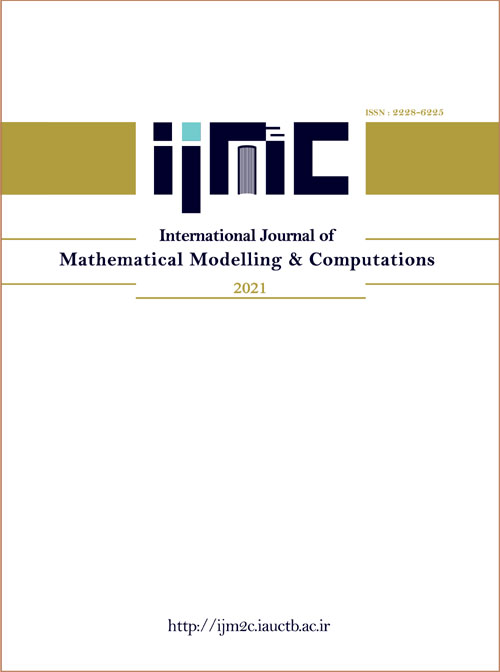فهرست مطالب

مجله بین المللی محاسبات و مدل سازی ریاضی
سال یازدهم شماره 4 (Autumn 2021)
- تاریخ انتشار: 1401/01/16
- تعداد عناوین: 6
-
-
Page 1
By taking into account that the computation of the numerical radius is an optimization problem, we prove, in this paper, several refinements of the numerical radius inequalities for Hilbert space operators. It is shown, among other inequalities, that if A is a bounded linear operator on a complex Hilbert space, thenω(A)≤½√(|| |A|2+|A*|2||+|| |A| |A*|+|A*| |A| ||),where ω(A), ||A||, and |A| are the numerical radius, the usual operator norm, and the absolute value of A, respectively. This inequality provides a refinement of an earlier numerical radius inequality due to Kittaneh, namely,ω(A)≤½(||A||+||A2||)½.Some related inequalities are also discussed.
Keywords: numerical radius, operator norm, Inequality, positive operator -
Page 2
So far, the numerous methods for solving and analyzing differential equations are proposed. Meanwhile; the combined methods are beneficial; one of them is the Optimized MRA method (OMRA). This method is based on the Father wavelets (dependent on the invariant solutions obtained by the Lie symmetry method) and correspondent MRA. In this paper, we apply the OMRA on the generalized version of FKPP equation (GFKPP) with function coefficientfutt(x,t) + ut(x,t) = uxx(x,t) + u(x,t) - u2(x,t),where f is a smooth function of either x or t.We will see that by the suitable Father wavelets, this method proposes attractive approximate solutions.
Keywords: Father wavelet, Multiresolution analysis (MRA), Invariant solution, Approximation subspace, Wavelet subspace, The GFKPP equation -
Page 3
In this paper, we have introduced a five‐parameter bivariate model by taking a geometric minimum of the modified exponential distributions. It is observed that the maximum likelihood estimators of the unknown parameters cannot be obtained in closed form. We propose to use the EM algorithm to compute the maximum likelihood estimators of the unknown parameters. A number of simulation experiments have been performed to determine the effectiveness of the proposed EM algorithm. We analyze two datasets for illustrative purposes, and it is observed that the proposed models and the expectation‐maximization algorithm perform at a satisfactory level.
Keywords: Expectation‐Maximization algorithm, geometric minimum, Maximum Likelihood Estimation, bivariate model -
Page 4
In this paper, we consider a nonlinear non autonomous system of differential equations. We linearize this system by the Newton's method and obtain a sequence of linear systems of ODE. We are going to solve this system on [0,Nl] , for some positive integer N and a positive real l>0 . For this purpose, in the first step we solve the problem on [0,l]. By knowing the solution on [0,l], we solve the problem on [l,2l] and obtain the solution on [0,2l]. We continue this procedure until [0,Nl]. In each partial interval [(k-1)l,kl], first of all, we solve the problem by the extrapolation method and obtain an initial guess for the Newton-Taylor polynomial solutions. These procedures cause that the errors don’t propagate. The sequence of linear systems in Newton's method are solved by a famous method called Taylor polynomial solutions, which have a good accuracy for linear systems of ODE. Finally, we give a mathematical model of the novel corona virus disease and illustrate accuracy and applicability of the method by some examples from this model and compare them by similar work, that simulate the numerical solutions.
Keywords: Novel corona virus model, Newton- Taylor polynomial solutions, Nonlinear ordinary differential equations, Long time, Extrapolation -
Page 5
In this paper we study the covid-19 disease with treatment and control to spread it with different measures. The model equations are analysed from the general MC Kendrick equations for age structured populations. The existence,positiveness,boundedness and stability of equilibria are studied as they depend on the prey's natural carrying capacity. The main result of this paper is the three age group population, how to control and avoid to infect the disease from predator with local,global stability and Hopf bifurcation method also utilised.Finally the result of this model prey predator where numerical examples using maple software of Rossler type.
Keywords: equilibrium point, Age group preys, Hopf Bifurcation, Stability switches, Carrying Capacity, Time-dependent, innate immune response -
Page 6
The aim of this paper is to provide a stability analysis for models with a general structure and mass action incidence; which include stage progression susceptibility, differential infectivity as well, and the loss of immunity induced by the vaccine also. We establish that the global dynamics are completely determined by the basic reproduction number R0. More specifically, we prove that when R0 is smaller or equal to one, the disease free equilibrium is globally asymptotically stable; while when it is greater than one, there exist a unique endemic equilibrium. We also provide sufficient conditions for the global asymptotic stability of the endemic equilibrium.
Keywords: Differential susceptibility, differential infectivity, waning vaccine induced immunity, Lyapunov methods

